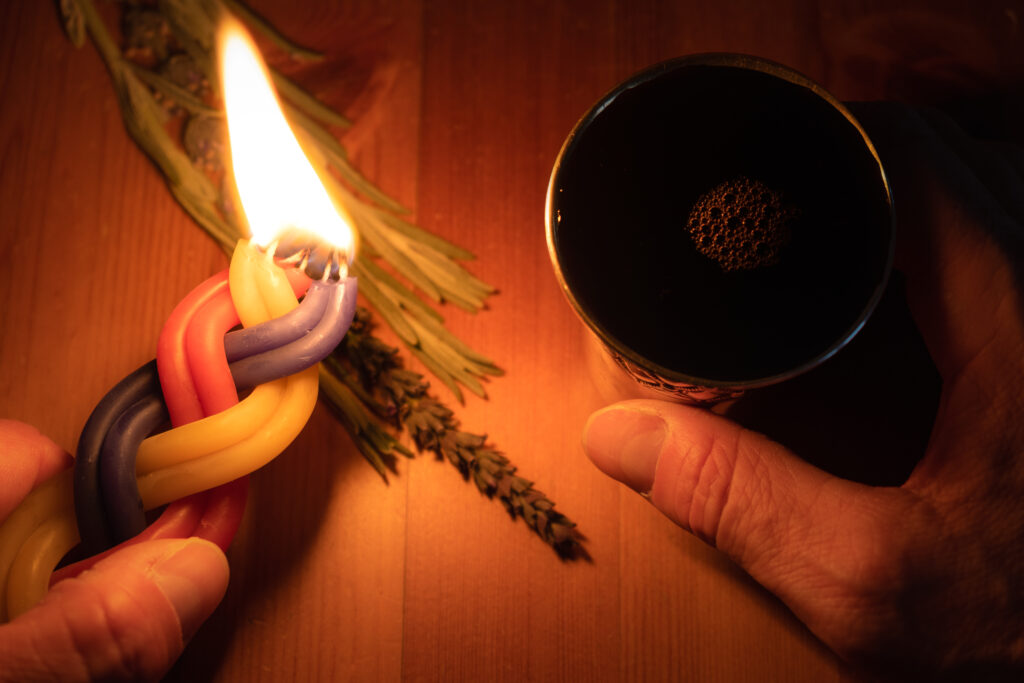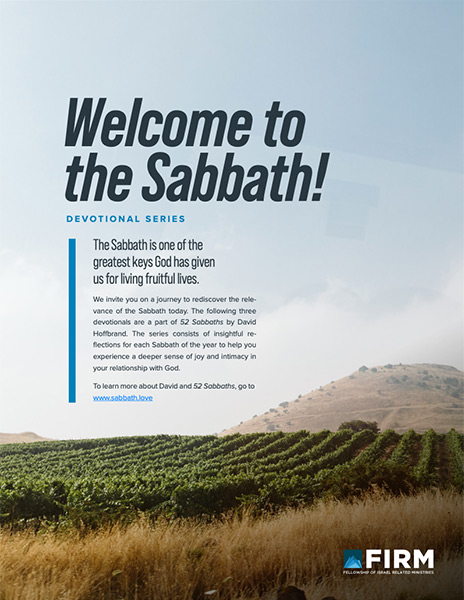What is Havdalah?
The Saturday sun dips below the horizon and the first stars appear in the twilight sky. Jewish families and friends worldwide gather to mark the end of Shabbat. The air fills with the sweet aroma of spices. A braided candle glows warmly. Voices unite in ancient blessings. This is Havdalah.
At its core, Havdalah is a ceremony of separation and distinction. It’s tools are wine, fragrant spices, a multi-wicked candle, and heartfelt blessings. Havdalah signifies the conclusion of Shabbat and welcomes the new week.
It is a multi-sensory experience. In other words, this practice engages the body, mind, and spirit. It aids our transition from the sacred to the everyday while carrying the essence (rest) of Shabbat into the days ahead.
Let’s understand this beautiful ritual more deeply. We will delve into its origins, explore its biblical connections, and uncover its spiritual significance. Then, we can discover its relevance for believers in Yeshua (Jesus) as the Messiah, together.
Origins and Biblical Connections
The word Havdalah comes from the Hebrew root בדל (badal), meaning “to separate” or “to distinguish.” This theme of separation is central to understanding the Havdalah ceremony and its significance. Though not explicitly commanded in the Torah, Havdalah embodies the biblical principle of sanctifying time by differentiating the sacred from the ordinary, especially in the observance of the Sabbath.
The concept of separation is introduced early in the Torah’s creation narrative. In Genesis 1:4, it is written, “God saw that the light was good, and He separated the light from the darkness.” This act of distinguishing is a recurring motif throughout Scripture, where God calls His people to be set apart—differentiating between the holy and the common, the clean and the unclean.
Havdalah Ritual
While the ritual of Havdalah itself is not explicitly mentioned in the Torah, it reflects the biblical imperative to honor the Sabbath. Exodus 20:8-11 underscores this commandment, stating:
“Remember the Sabbath day by keeping it holy. Six days you shall labor and do all your work, but the seventh day is a Sabbath to the Lord your God. On it you shall not do any work, neither you, nor your son or daughter, nor your male or female servant, nor your animals, nor any foreigner residing in your towns. For in six days the Lord made the heavens and the earth, the sea, and all that is in them, but He rested on the seventh day. Therefore the Lord blessed the Sabbath day and made it holy.”
The practice of Havdalah likely originated during the Second Temple period (516 BCE – 70 CE), when Jewish sages sought a formal way to mark the end of Shabbat. Over time, various customs developed within different Jewish communities, but the core elements—wine, spices, and light—have remained consistent.
Today, Havdalah continues to be a cherished tradition, linking contemporary practitioners with millennia of Jewish history and spiritual practice.
The Elements of Havdalah
The Havdalah ceremony typically involves four key elements, each rich with symbolism:
– Wine (or grape juice): Representing joy and abundance, the wine serves as a reminder of God’s goodness and provision.
– Spices: Usually contained in a decorative spice box called a *besamim*, the fragrant spices symbolize the sweetness of Shabbat and revive the soul as we transition into the workweek.
– Braided candle: The multi-wicked candle signifies the distinction between light and darkness, as well as the intertwining of the sacred and the ordinary.
– Blessing cup: An ornate cup is used to hold the wine or grape juice.
The Ceremony
Havdalah is traditionally observed after nightfall on Saturday evening. Jewish scholars say it is when three stars become visible in the sky, marking the definitive end of Shabbat and the beginning of a new week. And the order of the ceremony is as follows:
- Blessing over the wine
- Blessing over the spices
- Blessing over the lighting of the candle
- The Havdalah blessing itself
The final Havdalah blessing encapsulates the theme of separation. It sets the tone for the week ahead by distinguishing between the sacred and the mundane, the light and the darkness:
“Blessed are You, Lord our God, King of the universe, who separates between holy and ordinary, between light and darkness, between Israel and the nations, between the seventh day and the six days of work. Blessed are You, Lord, who separates between holy and ordinary.”
Havdalah in a Jewish Home
For those interested, here is a step-by-step guide how traditional Jews perform Havdalah. They:
- Gather the elements: wine or grape juice, spices (commonly cloves or cinnamon), a multi-wicked Havdalah candle, and a Kiddush cup.
- Begin after nightfall when they can see three stars in the sky.
- Light the Havdalah candle, but don’t recite the blessing yet.
- Hold the cup of wine or grape juice and recite the blessing over the wine.
- Pick up the spice box, recite the blessing over the spices, and pass it around for everyone to smell.
- Recite the blessing over the candle, raising their hands to the flame with palms facing inward, fingers curled.
- Recite the final Havdalah blessing, distinguishing between the holy and the ordinary.
- Drink from the wine cup.
- Extinguish the candle in the remaining wine, symbolizing the end of Shabbat.
The goal of this ritual is to create a meaningful transition from Shabbat to the new week. Nevertheless, these steps are not biblically mandated, so they remain a tradition that the Jewish people can choose to follow.
The Wisdom of Havdalah
Having explored the meaning and practice of Havdalah, we can appreciate the profound wisdom it offers. More than simply marking the end of Shabbat, the Havdalah ceremony provides valuable insights for our everyday lives.
Some important takeaway lessons from Havdalah include:
- Mindfulness of Time: Havdalah helps us transition intentionally from Shabbat rest to the workweek, encouraging us to carry the peace and joy of Shabbat into our daily lives.
- Family Unity: The ceremony provides an opportunity for families to come together, reinforcing the importance of spiritual practices in the home.
- Sensory Worship: By engaging multiple senses (taste, smell, sight, touch), Havdalah reminds us to worship God with our whole being.
- Continuity with Jewish Roots: Practicing Havdalah connects us with the rich heritage of our faith and the continuous stream of God’s work among His people Israel.
- Opportunity for Outreach: The beauty and meaning of Havdalah can serve as a conversation starter with both Jewish and Gentile friends, opening doors to share about our faith in Yeshua.
Spiritual Significance for Messianic Believers
The Havdalah ceremony takes on additional layers of meaning and symbolism when viewed through the lens of faith in Messiah Yeshua. When we approach any tradition, we should ask ourselves how it is enhancing our relationship with our Lord. Is Havdalah also pointing at our Savior?
Yeshua as the Light of the World
The multi-wicked Havdalah candle can remind us of Yeshua’s words in John 8:12, “I am the light of the world. Whoever follows me will never walk in darkness but will have the light of life.”
The Havdalah candle illuminates the darkness at the end of Shabbat. So, too, Yeshua illuminates our path and guides us through the spiritual darkness of this world.
The Aroma of Messiah
The fragrant spices used in Havdalah may represent the “aroma of Messiah.” It’s described by Paul in 2 Corinthians 2:14-15:
“But thanks be to God, who always leads us as captives in Christ’s triumphal procession and uses us to spread the aroma of the knowledge of Him everywhere. For we are to God the pleasing aroma of Christ among those who are being saved and those who are perishing.”
The New Covenant in His Blood
The wine used in Havdalah gains deeper significance when we consider Yeshua’s words at the Last Supper. Those were: “This cup is the new covenant in my blood, which is poured out for you” (Luke 22:20).
As we partake of the wine during Havdalah, we are reminded of the ultimate separation between sin and righteousness achieved through Yeshua’s sacrificial death and resurrection.
Set Apart for God’s Purposes
The concept of separation in Havdalah resonates with the calling of believers to be set apart for God’s purposes. As Peter writes in 1 Peter 2:9,
“But you are a chosen people, a royal priesthood, a holy nation, God’s special possession, that you may declare the praises of Him who called you out of darkness into His wonderful light.”
Conclusion
As we learn of Havdalah traditions, we can be reminded of Yeshua’s light in our lives, the fragrance of His presence, and the new covenant established through His blood. In other words, we are called to be a people set apart. We are distinguished by our faith and actions, and we carry the holiness of Shabbat into the ordinary days of the week.
If anyone chooses to practice Havdalah, may it be a reminder of our high calling in Messiah Yeshua—to be a light to the nations and a fragrant offering to our God.
As we make this weekly transition, let us go forth with renewed purpose, carrying the peace of Shabbat and the power of the Ruach HaKodesh (Holy Spirit) into a world that desperately needs the hope and redemption found in Yeshua.
In embracing some Jewish traditions, like Havdalah, we can fulfill the words of the prophet Jeremiah: “This is what the Lord says: ‘Stand at the crossroads and look; ask for the ancient paths, ask where the good way is, and walk in it, and you will find rest for your souls.'” (Jeremiah 6:16).
Articles Related to What is Havdalah? The Hebrew Word for Separation
Estimated reading time: 9 minutes


